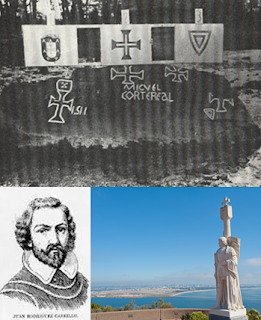Dear Folks,
As you know many times in my Blog I speak about history (as it is one of my favourite subjects), I have many times explained how my country (Portugal) managed to influence the world as we know it today.
Because my Blog is mainly visited by Americans from the States, today I am going to speak about two Navigators that probably you have never heard about.
Miguel Corte Real was a Navigator that explored the east coast of the US and reached Florida in 1511, years prior to the arrival of the English pilgrims. Proof of this voyage was found in 1910, the so-called “Dighton Rock” has inscriptions of the Portuguese sailors that were there.
There are also other remains of Portuguese presence in US prior to Spanish or English (Newport Tower in Rhode Island, Ninigret Fort remains in Charlestown/Rhode Island and some Portuguese canons and swords).
Joao Rodrigues Cabrilho (or Cabrillo as it is known in USA) was a Portuguese Navigator that sailing under Spanish flag (like Fernao de Magalhaes or Magellan) made the first exploration voyages of the US West coast. They were searching for a passage from the Pacific to the Atlantic ocean.
Cabrilho had in his armada several other Portuguese sailors with him, the other famous one was called Sebastiao Rodrigues Soromelho. Why talk about this sailor in particular? Well, this sailor was natural from a Sea Town in Portugal called Sesimbra (not far from Lisbon), in this town there’s a famous beach called Califòrnia, the origin of this name comes from a “fornus of Cal” (or in English Lime or Whitewash). So CAL (lime/whitewash) plus FORNIA (fornus/fire oven) equals CALIFORNIA, there are written records in Portugal prior to the exploration of the California coast where the name "Praia da Califòrnia" already appears (similar situation is the name of the Portuguese Town of Cuba that already existed prior to the arrival of Colombo to that island).
When Soromelho arrived at the shores of that new land that reminded him of his native town he named it California.
There you go, you have now a new story to tell your friends and family. The Portuguese influence in America in both shores.
Be sure to go and pay a visit to San Diego to Cabrillo’s National Monument, it is a wonderful location that overlooks the Pacific Ocan. There’s a huge statue of Joao Rodrigues Cabrilho under a Portuguese Padrao dos Descobrimentos (Portuguese Discoveries Land Mark). Or to San Miguel Island by Santa Cruz where his resting place is.
Or to go to visit Dighton Rock in Berkley, Massachusetts.
I hope that you lovers of a good story have enjoyed this Post and that you will find appealing to have a more exotic background.
Enjoy diversity and enjoy good food.
Bon Apetit,
Chef Gourmet Du Art




